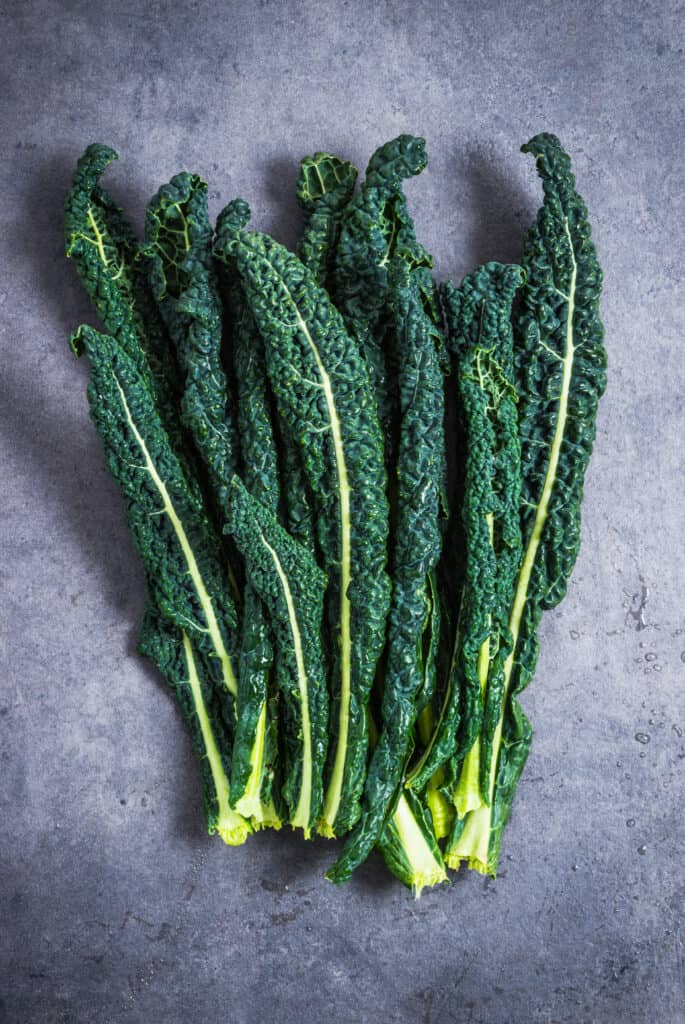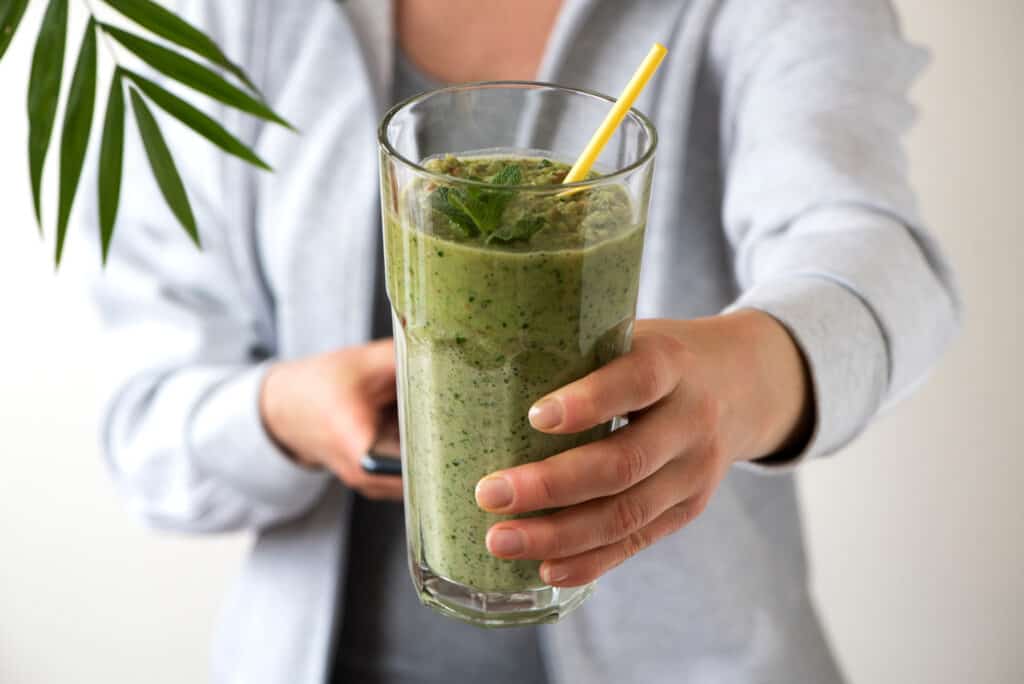Arugula vs. kale – what’s the real difference between these two leafy green vegetables? They’re both great in salads and smoothies and work as amazing blend-ins on a number of other dishes.
They’re also completely different plants, with different growing needs, different uses, and some amazing and fun facts that you might not think about when it comes to salad greens.
Let’s check out the unique qualities of these two tasty leaves and see how you can best grow and use them in your own garden and cooking.

Fresh arugula served raw is your best bet for health benefits.
©Sea Wave/Shutterstock.com
| Arugula | Kale | |
|---|---|---|
| Classification | Eruca sativa; two main types with multiple varieties | Brassica oleracea var. sabellica; five main types, with many varieties |
| Description | Arugula is a leafy green vegetable with a mustard-like or peppery flavor, with medium to dark green leaves. | Kale is a winter harvest plant with long rosettes of elongated leaves with frilled edges. The plant may be anywhere from blue green to red and anything in between. |
| Uses | Technically an herb, arugula is most often used in salads, sandwiches, soups, and other dishes requiring a zesty leafy green or garnish. The plant is believed to help prevent certain cancers and ailments, and is best when consumed raw. | Containing may vitamins and nutrients, kale has been dubbed a super food. The leafy cruciferous vegetable is most often used in salads and smoothies for dietary purposes. |
| Origins and growing preferences | Arugula comes from the Mediterranean and southern Europe, dating back to the Old Testament and Jewish Talmud days. It should be planted in full sun, in nutrient-rich soil. | Originating in the eastern Mediterranean and Anatolia, kale dates back as far as 2000 BCE. The plant does best when placed in full sun, in well-drained, and compost-rich soil. |
| Special features and fun facts | Arugula comes in a wide variety of species with leaves in many shades, some of which look like dragon’s wings. The herb is used in many dishes around the world, including soups, salads, and fish dishes. | Kale has a ton of nutrients that are more absorbable than in other foods, like calcium – which it has more of than milk. |
Key Differences Between Arugula and Kale
These two leafy greens are popular for many salads, smoothies, and other healthy foods. But there are some key differences that could change how you decide you use them in your next meal. You could also decide that a combination of both is the best plan of action for your healthy eating plan. Check out the seasons for planting and harvesting and you might find they’re the perfect blend.
Arugula vs. Kale: Classification
Arugula is also known as rocket, roquette, rucola, and eruca. The leaves from the plant look a bit like oak leaf shaped dandelion greens. The plant is officially deemed an herb, though you’ll typically find it in the lettuce section of the grocery store and plants. Arugula is part of the brassicaceae family, which is a cruciferous veggie family. Others in the family are broccoli, Brussels sprouts, cabbage, turnips, kohlrabi, and cauliflower. Arugula has two main forms, the wild rocket which has smaller pepperier leaves, and wide leaved cultivated rocket that has a less distinctive taste.
Kale on the other hand is part of the brassica oleracea family, or rather cabbage family. The leafy green is also known as leaf cabbage for good reason (the flavor). Some forms of kale are used as ornamental plants, as well, though most of the ones we are typically familiar with are the edible plants that get tossed into smoothies and salads. There are three main types of kale, including curly kale, black kale, and red kale. When you look in the grocery store, you can easily tell the three types apart by their monikers, which explain their looks.

Fresh kale, ready for use in salads, smoothies, and more.
©leonori/Shutterstock.com
Arugula vs. Kale: Description
Arugula has been described as having either a “mustardy” or “peppery” flavor seeped deep into its dark green leaves. The plant is closely related to broccoli, cauliflower, and Brussels sprouts, in the cruciferous family. The family is known for its intense flavors and earthy tones for sure, and arugula doesn’t disappoint in that area! The younger the plant, the softer the flavor, though, but baby arugula is often pickled.
Kale though, comes from the cabbage or mustard family, harvesting in the winter months, bringing forth its unique flavor. The plant produces rosettes of elongated leaves that tend to be frilly looking on the edges. The leaves can be anywhere from blue green to purple, light green, or even red, based on the variety. The stem of the plant will often get to 2 feet in height when left to full maturity. The plant produces yellow four-petaled flowers, too, which come in loose clusters in the plant’s second year.
Arugula vs. Kale: Uses
Arugula is technically an herb, but most of us would probably think of the leafy green as a salad green instead. The cruciferous vegetable is used for a number of things, though, including salads and meals, as well as oil from the seeds for cooking, hair care products, and more. Arugula contains calcium, iron, protein, carbohydrates, a minimal fat, sodium, Vitamin A, Vitamin C, Vitamin K, Folate, Potassium, and Magnesium, as well as compounds that function as antioxidants. The health benefits of arugula are often thought to be helpful in protecting against various cancers like lung and colon, as well as fighting inflammation.
Arugula in its raw form is the healthiest option, providing you the most nutrients possible. Many folks toss arugula into salads, as pizza toppings, on sandwiches, in smoothies, in frittatas and omelets, in soups, sauces, and on pasta dishes.

Both kale and arugula are often used in green health smoothies.
©Poberezhna/Shutterstock.com
Kale is, for some, a more familiar leafy green used in smoothies, thanks to its intense popularity in the health food industry in recent decades. The leafy vegetable has often been touted as a “super food” and used in many health food products. The leafy vegetable has many nutrients that helps it earn this reputation and frequent use. The leaves contain Vitamin K, Vitamin A, Vitamin B6, Vitamin C, calcium, potassium, manganese, and copper, is low in calories, and low carbohydrates, making it popular with many food fads and nutritionists. The cruciferous veggie is thought to help fight or prevent cancer. Those who take warfarin or deal with kidney stones are recommended to limit kale intake, however, as the high levels of certain nutrients may interfere with proper health care.
People often use kale in salads and smoothies and make kale chips from the leaves once they have been stripped from the middle rib of the leaves.
And if you want a really unique, tasty smoothie (not for the sweet tooth), combining kale and arugula together can make an exceptionally nutrient-rich meal replacement. Add some oats, pear, and banana for a truly unique flavor that really packs a punch.
Arugula vs. Kale: Origins and Growing Preferences
Arugula is one of those plants that does well when it is planted in the autumn. Kale, on the other hand, is harvested in wintertime and is planted earlier in the year. The two plants thrive in similar regions of the world, though, so they help create a balanced harvest schedule.
Arugula is native to the Mediterranean region and southern Europe, dating back at least at far as ancient Rome and even further to the Old Testament days. The plant is actually mentioned in both the Bible and the Jewish Talmud, harvested as early as the 6th Century BCE. Later, Virgil mentioned the leafy herb in his poem, discussing his favorite salad green. Pliny mentioned the plant in The Elder’s Historia Naturalis, circa 77 AD. Interestingly, the plant was believers to be both an anesthetic and an aphrodisiac, popular throughout Europe and eventually the Americas. Morocco, Portugal, Turkey, and Italy have long used the leaves in their meals, as have Americans, but it wasn’t until the 1990s when the leafy herb became popular in the USA.

Arugula loves full sun and well-drained, nutrient-rich soil.
©vaivirga/Shutterstock.com
Arugula does best when planted in nutrient-rich, well-drained soil. It thrives in containers, raised beds, and traditional garden beds alike, and should be planted in full sun for best results.
Kale comes from the northern Middle English word “cale,” which means cabbage. This makes sense, since it’s the “leafy cabbage.” The plant originally came from the eastern Mediterranean and Anatolia, dating back as early as 2000 BCE as a cultivar in many gardens. We know that Greek gardens held the plant as far back as 4th Century BCE. Western Europe didn’t have kale, from what we can tell in records anyway, until the 13th Century, with the first distinction in records between “hard head” and “loose cabbage” (kale) in the 14th Century mentioned. Russian kale made its way to Canada, followed by the United States, in the 1800s, when botanist David Fairchild is credited with the introduction.
Kale should be planted 3 to 5 weeks before the last frost of the spring, spacing them 18 to 24 inches apart in full sun, with well-drained soil that’s been compost enriched.
Arugula vs. Kale: Special Features and Fun Facts
There are many varieties of arugula, some of which have some pretty fun names that represent unique characteristics of that particular species. Red dragon, for example, has leaved that resemble oak tree leaves that sort of resemble a dragon’s wings. If you want a fast-growing variety, though, go with Selvetica – it’s the fastest known variety available.
In Turkey, arugula is used, raw, with fish or as a side dish with virgin olive oil and lemon juice. But in countries like Slovenia, the leaves are boiled up with potatoes to create a zesty soup. And in Italy, it’s often used to top pizzas. And if you’re looking to burn some fat, arugula is a great choice for your diet – it contains a compound known as sirtuins, which is a natural fat burner.

Thanks to its zesty flavor, arugula is fantastic as both a leafy green and an herbal topper.
©Ratov Maxim/Shutterstock.com
It might surprise you, but kale actually has more usable (absorbable) calcium than a serving of milk. It’s also often been used not just as food but as “medicine” to help correct dietary lacks, since it contains a ridiculous amount of nutrients that the body needs beyond just that calcium. And though some folks have rumored that this leafy green causes hypothyroidism, there’s no actual evidence that it does. It can, however, cause issues for those taking blood thinners, so if you’re on that kind of medication, check with your doctor before bumping up your intake.
Next Up:
The photo featured at the top of this post is © leonori/Shutterstock.com
Sources
- Britannica, Available here: https://www.britannica.com/plant/kale
- Mayo Clinic, Available here: https://www.mayoclinichealthsystem.org/hometown-health/speaking-of-health/the-many-types-and-health-benefits-of-kale
- WebMD, Available here: https://www.webmd.com/food-recipes/benefits-arugula
- Almanac, Available here: https://www.almanac.com/plant/arugula
- B&W Growers, Available here: https://bwqualitygrowers.com/arugula/history-and-facts/
- Bonnie Plants, Available here: https://bonnieplants.com/blogs/how-to-grow/growing-kale
- Food Matters, Available here: https://www.foodmatters.com/article/17-fun-facts-about-kale
- Farmer's Almanac, Available here: https://www.farmersalmanac.com/what-the-heck-is-arugula-11987
Thank you for reading! Have some feedback for us? Contact the AZ Animals editorial team.






